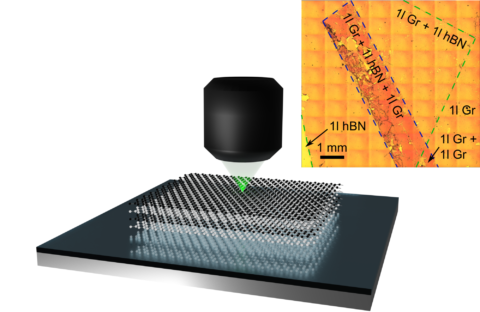GRK members develop method for determination of heterogeneously stacked Van-der-Waals materials by optical microspectroscopy
GRK research results in novel apporach for determining the number of layers of 2D materials
In a recent publication, a team of researchers of the GRK 1896, TU Dresden and Fraunhofer IISB developed an approach for conclusively determining the number of layers of different 2D materials within Van-der-Waals heterostructures via using reflectance microspectroscopy and an advanced data evaluation scheme. They demonstrate the appicability of this method by investigating 2D heterostructures containing the ultra-thin materials graphene and hexagonal boron nitride (hBN). In particular, reflectance spectra of the stacked 2D materials were recorded by utilizing a simple optical microscope equipped with a spectrometer for visible light. When passing the 2D materials, the spectrum of light reflected on their surface slightly changes and deviations in absolute reflectance and spectral position of extreme values are determined. These deviations, however, are extremely small and a proper discrimination between different 2D materials requires an accurate physical model. This model includes not only an optical transfer-matrix of the subjacent layer stack but also correction terms for the numerical aperture of the used objective lens as well as for a waveguide for coupling the light into the spectrometer. The authors gained ultimate detection limits of wavelength shifts below 1 nm and changes in absolute reflectance below 1%. With this precision it was possible to unequivocally discriminate two of the thinnest functional materials i.e., graphene and hBN in 2D heterostructures by optical microspectroscopy as well as to determine their individual number of layers. This particular method opens up new horizons by enabling non-destructive, in operando characterization of electronic devices based on Van-der-Waals heterostructures.
Further information
Dr.-Ing. Dr.-Ing. Andreas Hutzler
Department of Electrical, Electronic and Communication Engineering (EEI)
Chair of Electron Devices
- Phone number: +49 9131 85-28638
- Email: andreas.hutzler@fau.de
Birk Fritsch, M. Sc.
Department of Electrical-Electronic-Communication Engineering
Chair of Electron Devices
Paper
The work was published open access in Scientific Reports.
Hutzler et al., Sci. Rep. 10, 13676 (2020)
DOI: 10.1038/s41598-020-70580-3

